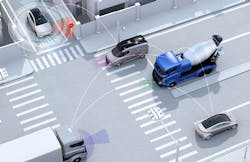Electrification. Artificial intelligence. Virtual reality.
At the outset of 2020, those are just a few of the biggest issues that appear poised to impact the collision repair realm.
How will such evolving forms of technology change the face of the industry? FenderBender spoke with several experts to gauge the foreseeable future of the vehicles set to roll across shop floors.
Collectively, the group provided a clear view of what’s ahead. Here’s the five biggest issues that are accelerating to the forefront.
THE TREND: ARTIFICIAL INTELLIGENCE
If Fred Iantorno ever needs a reminder of technology’s evolution, all he has to do is check his home’s thermostat.
“A form of AI [artificial intelligence] is sitting on my thermostat in my house,” Iantorno explains. “It knows when I’d like to lower the temperature. It knows what time I go to bed, because at that time I turn the thermostat down. And then it asks ‘Do you want me to do it for you?
“It has learned my habits.”
Iantorno, currently the vice president of IoT (the Internet of Things) with VeriFacts Automotive, has worked in the information technology field for 37 years. And, he’s never been so certain of one thing: technology is growing at a virtually unprecedented rate, and it’s especially apparent in the collision repair industry.
“People used to call these things ‘emerging technologies,’” Iantorno notes. “Well, they’re not emerging anymore. They’re here today, and they’re all around us.”
As the intuitive thermostat on Iantorno’s wall suggests, AI, especially, is creeping into virtually every facet of our society. Our smartphones are fueled by it. And, to a growing extent, AI is fueling vehicles nearly as much as unleaded or diesel. AI is already impacting body shops in the form of photo estimating, for example.
“AI is the engine that drives that,” Iantorno says of photo estimating. “Whether it originates from the vehicle itself or your smartphone, intelligent first notice of loss—FNOL—is another AI function. So, [AI] is all around us today.”
THE TAKEAWAY:
But collision repairers needn’t fear this brave new world. Iantorno feels that shop operators don’t necessarily need a thorough working knowledge of AI to benefit from it. They simply need to be aware of how it’s starting to drive change within the industry.
Technology like AI is undoubtedly growing exponentially—as much in the last five years as the previous 50, Iantorno contends. And, that presents opportunities to improve shop floor efficiency, through elements like quick photo estimates.
“AI will accompany every disruptive technology implemented going forward,” Iantorno says. “Even though we might not want to, we’ve got to embrace this change. Because, if you don’t embrace the change, it will run over you. Because there’s no way to stop this.”
But, the technology expert adds, “If you embrace it, it’s fun. It can be fun.”
THE TREND: ELECTRIFICATION
umlaut, inc. is a global consulting and engineering firm with nearly 650 automotive consultants and engineers at its disposal in North America alone.
And, right now, many of them are focused largely on electrification.
Over “the next five years, we’ll see much increasing amounts of electrification—from just more plug-in hybrids to full battery electric vehicles,” says Dr. Samit Ghosh, the CEO of umlaut in North America. “All automakers will go much stronger in that timeframe into electrification.”
Newer automakers, like Tesla, have a clear agenda moving forward, Ghosh says: focusing on electric vehicles. Meanwhile, legacy OEMs all have different timelines, driven by the markets they operate in; in China, for example, regulations demand that automakers dedicate a certain percentage of their fleet to EVs.
But, the umlaut CEO adds, “overall, everybody is going that way.”
Multiple industry insiders that FenderBender spoke to for this report had similar bold predictions regarding the future of EVs. A key factor pointing the auto industry toward an electrified future is the increased range EVs are starting to provide.
“We’ll see a lot of ‘skateboard technology’—where [manufacturers] put the battery on the floor of the vehicle,” Ghosh explained. “What’s more important, though, is the capability of the vehicle in terms of acceleration and performance. … Battery technology will become better and translate into more range.”
And that’s likely to reduce “range anxiety” that many consumers currently have, in which they’re nervous about taking EVs on extended road trips, the umlaut CEO contends.
THE TAKEAWAY:
The shift toward increased electrification means those working at automotive repair facilities will need thorough training on how to avoid safety concerns.
“The safety piece is probably the biggest threat,” Ghosh notes. “With electrification, there’s safety concerns and … there’s proper training [needed] to operate batteries with high voltage.”
Ghosh has a ph.D in mechanical engineering, and even he isn’t certain just how widespread the adoption of EVs will be five years from now. But he’s certain that EV use will increase from where it’s at right now. And repairing those evolving vehicle types will require shops to make an adjustment.
“It’s just a different world,” Ghosh notes, “rather than having just a couple wrenches like it was.”
THE TREND: VIRTUAL/AUGMENTED REALITY
As the global solutions designs manager with Bosch, Shawn Dupuie focuses on training repair professionals like technicians. And, these days, that training is greatly aided by virtual reality.
Last year, at a trade convention in Las Vegas, Bosch launched its virtual reality project in earnest. The experience left the gathered crowd as intrigued about VR as Dupuie is.
Bosch began helping repair facilities utilize VR training as a method to help shore up the automotive industry’s technician shortage.
“The average [technician] age in the U.S. is 50 years old,” Dupuie notes. “Most of our customers are coming to us saying, ‘We’re having a really tough time recruiting the new generation to be a technician: In what way can you help us?’”
In an attempt to appeal to a younger generation that grew up on video games, Bosch began offering virtual reality training in earnest.
THE TAKEAWAY:
Cost-effectiveness. Virtual reality training, over the long haul, is far more cost-effective than traditional methods that often require paying employees to travel, Dupuie notes.
While VR setups cost around $4,000 not long ago, the price is dropping fast. Dupuie says the price entry point is now $600 for stand-alone VR hardware and an accompanying headset.
“The distance learning element of VR is powerful,” Dupuie says. “The instructor can be anywhere in the world. At the independent shop, they’re [often] limited in space to conduct training. So, they end up going to hotels, or they end up going to a training center. With the virtual reality, you can do it in a very small space; with VR you don’t have to have a 20-by-20 room.”
Retention of information. Hands-on learning typically resonates with auto industry professionals like technicians, who are used to working with their hands.
“What we’ve found with virtual reality is, it seems technicians retain knowledge better than with web-based training,” Dupuie says. “We did research and found that most technicians retain about 10 percent of what they read, about 50 percent of what they see and hear, and almost 90 percent of what they do. Technicians have had a high success rate of retention with VR.”
Increased safety. Considering the industry is slowly but steadily becoming more mobile and electric, Bosch officials appreciate the fact that VR training offers a safe environment in which to train.
THE TREND: BLOCKCHAIN
The term “blockchain” is difficult to define, even for many technology experts. Yet, automotive insiders are confident blockchain could redefine many elements of the industry, such as the parts supply chain.
Blockchain refers to an ever-expanding list of records that are linked within a distributed, private, public, or permissioned ledger thanks to technology that allows information to be disseminated but not copied, and altered only by those that have access to it. The process helps limit the opportunity for information to be compromised via hacking because it’s transmitted via a peer-to-peer network with no server.
“Most people have heard about blockchain and about Bitcoin, but it’s a lot more than that,” notes Iantorno, the VeriFacts executive whom had served as the longtime executive director of CIECA until 2019. “It’s actually an underlying technology in which you have distributed, digital ledgers—everybody has a copy of the entire ledger. It’s a technology by which you have all the data and, if somebody changes the data, a copy of that change shows up to you.”
And, in the digital age, that’s quite necessary, says Tim Pfeifle, who operates Auto Body of Tyson’s Corner, a $12 million shop in Vienna, Va.
“The more you can protect yourself and have secure relationships with vendors and manufacturers, it’s huge,” says Pfeifle, a veteran of nearly four decades in the industry. “Most [shop owners] probably don’t realize how easily they can be hacked. If customers’ information is available in your system, then you have a breach possibility, and that’s not good.”
THE TAKEAWAY:
While blockchain is often used these days in both the healthcare and financial sectors, manufacturers have especially started to utilize the technology as they look to improve their supply chain. And Iantorno sees plenty of other possibilities for blockchain within the collision repair space, because information (and payments, for example) can be made in real time.
“Think about blockchain in terms of the documentation from the first notice of loss, to the estimate, to the repair order, to the parts order,” Iantorno says. “Through every step of the cycle and into final settlement; all that information is sitting in this blockchain. And everyone [within the specific network] has access to those pieces of the data.”
There are current pilot programs pertaining to blockchain, the VeriFacts executive says, that are utilized by insurance companies and parts manufacturers.
THE TREND: INCREASINGLY CONNECTED VEHICLES
umlaut executive Ghosh—someone as plugged in to the industry as anyone—expects vehicle connectivity to make a major impact on collision repair in the next five years.
Because, Ghosh notes, “the car has a modem built in” nowadays. Vehicle over-the-air improvements, as well as vehicle diagnostics and telematics data-management, will likely be aided later this year when 5G technology becomes accessible on a wide scale. Because, as VeriFacts’ Iantorno notes, 5G offers lower latency than 4G and it’s more responsive, meaning messages can be sent and received faster than ever.
Unprecedented levels of connectivity could especially impact telematics, according to Ryan McMahon, the vice president of insurance and governmental affairs with Cambridge Mobile Telematics.
“Anyone that buys auto insurance is certainly seeing the impact of price increases,” McMahon notes. “And one of the main drivers behind that has been an increase in accident frequency. Insurers [responded with] increased prices in general.
“But, one of the ways the price increases are being rolled back is through the use of telematics to help understand how an individual drives. We have the ability to understand someone’s smartphone distraction from looking at the sensors on their phone. About 25 percent of our crashes we see significant phone distraction happening moments before the crash.”
THE TAKEAWAY:
While devices had long been plugged into vehicles’ OBD ports to provide crash information, McMahon notes that, in 2020, mobile phone technology has advanced to the point that it can provide more thorough information about how drivers tend to operate a vehicle relative to factors like acceleration and braking.
“In case an accident does happen, now, with mobile telematics,” McMahon explains, “we can sense that a crash occurs and then deliver emergency response to the scene.”
While body shops figure to see less plug-in telematics devices moving forward, they’re certain to see the results of telematics that utilizes’ drivers’ cellphones, McMahon says.
“It’s very possible that, when the vehicle’s brought into the shop,” he says, “it’s also accompanied by a report of the accident that can be automatically generated as a result of machine-learning … from a customer’s mobile phone that they, themselves, after the crash push to all relevant parties.”

